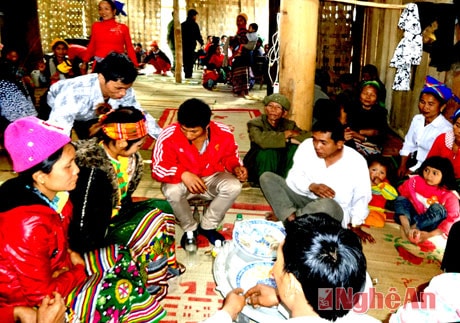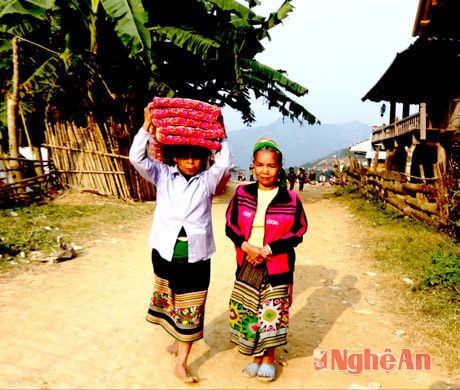Wedding customs of the Khmu people
(Baonghean) - The wedding customs of each community have their own interesting features. For the Khmu people in Western Nghe An, when asking for a wife, meat, fish and especially squirrel meat are essential; all are dried in the kitchen, months before the big day...
For the Khmu people, after the harvest season is the occasion to celebrate the new rice and also the wedding season. The wedding season lasts until after Tet when they prepare to clear the land. After the harvest, when the village is most prosperous, the weather is cool, a good time for young couples to build new homes. Perhaps that is why, from the 9th and 10th lunar months until the end of January, in the Khmu villages, there are often more weddings than ever...
The same is true for Pung Ca Moong village (Luong Minh commune - Tuong Duong) located next to Ban Ve Hydropower Lake. From the harvest to the Lunar New Year of Giap Ngo (2014), dozens of weddings were held. The old village of 140 Khmu households was submerged under the lake. They have moved to the new place for 4 Tet holidays. Life at this resettlement site is not yet stable. Difficulties still pile up, but when organizing weddings for young couples, the family still takes care of them to be equal to the village.
It is said that the Khmu are one of the oldest communities living in the Western region of Nghe An. Having gone through many ups and downs, this community still retains many unique cultural features, including wedding customs that cannot be confused with any other ethnic group. We arrived at Pung Ca Moong village, when Mr. Cut Van Lien's family was preparing to send his youngest daughter Cut Thi May to her husband's house. The joy was doubled when the wedding fell on the traditional New Year. For many years, the Khmu in Pung Ca Moong village have celebrated the Lunar New Year like people in the lowlands and weddings are also gradually being renewed to avoid fussiness and waste. Child marriage has become much less common. Mr. Lien only allows his daughter to go to her husband's house when she turns 18.
 |
| Ceremony at a Khmu wedding, Pung Ca Moong village (Luong Minh - Tuong Duong). |
Over a jar of rice wine on his daughter's wedding day, Mr. Cut Van Lien told about the wedding customs of the Khmu people... I don't know since when, in the Khmu villages there has been a very strange wedding custom. When a grown-up son finds a girl he likes, he immediately returns to tell his parents to set a date to ask for her hand in marriage. Months before the wedding day, the groom's family must go down to the stream to fish, go up to the forest to hunt squirrels, and slaughter pigs to make dried meat in the kitchen loft. Because meat, stream fish, and dried squirrel meat are indispensable gifts when asking for a wife. In addition, like the Thai or Mong people, the family chooses someone from the family to be a "matchmaker" to ask for a wife for their son. The only difference is that the Thai people only have one matchmaker, while the Khmu people have two matchmakers.
In the community, how many people can explain this rather strange custom of asking for a wife? People only know that it is something that their ancestors passed down. During the engagement ceremony, the bride's family will set a dowry. Until now, many places still have the custom of asking for a dowry with chickens, pigs, and silver ingots. However, in Pung Ca Moong village, the dowry with silver ingots has been abolished, because nowadays, one silver ingot costs nearly 20 million VND, and is very difficult to find. It must be said that the dowry has become a burden for many families, especially in the old communities. Mr. Cut Van Lien said that in the past, when he asked for his wife, his family had to sell their herd of cows to prepare a proper wedding. Therefore, when the groom's family came to ask for his daughter's hand in marriage, he did not ask for a dowry as high as before. The wedding had pigs, chickens, wine, and rice to worship the ancestors in accordance with the custom. Of course, in the engagement as well as the wedding ceremony, there must be rice wine and wine cooked in a steamer (lau xieu), usually 2 jars of rice wine and 4 bottles of "lau xieu". In the engagement, the two families will set a wedding date for the young couple. The small wedding date as well as the official wedding date is usually decided by the groom's family. We also see this custom among the Thai people in Con Cuong, Tuong Duong... However, for the Khmu people, the small wedding day must have 2 matchmakers present (for the Thai people, there is only 1 matchmaker). On the day of the engagement, the groom's family must also have all the relatives present, so the small wedding is often as grand as the official wedding day.
 |
| Bring a mattress for the bride when she goes to her husband's house. |
According to our research during the times we had the chance to visit Khmu villages in Ky Son, in many areas such as Muong Ai, Keng Du, the wedding ceremony has been organized simply. Typically, in Muong Ai commune, the bride's family only takes a dowry of about 300,000 VND for formality. This is thanks to the propaganda work of the district's Culture Department after many years. Head of the Culture Department of Ky Son district, Mr. Moong Van Nhi said: Implementing Resolution 27 of the Politburo, the District People's Council also had a resolution on implementing village covenants in funerals and weddings, many bad customs have been abolished, the wedding is held in one day. The official wedding day is also the most anticipated day. On the main wedding day, the bride's family is often organized more lavishly. All the work from slaughtering pigs and chickens, to arranging trays, even the dishes are taken care of by the groom's family. The Khmu people believe that when you marry someone else's daughter, you have to take care of everything yourself. At this time, the girl's family is just like invited guests.
Regarding the wedding procession, the Khmu people in Ky Son (Keng Du commune) often take the bride home at night. The Khmu people's wedding procession in Keng Du usually takes place when the rooster is about to crow in the morning. According to the people's concept, this is a quiet time when there are usually no obstacles on the way to the bride as well as in the life after. There is another part of the community, they take the bride home during the day. We can also find the night wedding procession in many Thai communities in Con Cuong district.
In the wedding procession, the groom's family usually sends 12 or 16 people. The people chosen to pick up the bride also come from standard families, with a good economic status compared to their clan, and have social status. This shows the newlyweds' desire to have a family that will also become well-off and peaceful in the future. The number of people in the wedding procession when going to and returning to the groom's house must be an even number.
When the wedding procession is on its way back and about to enter the house, the groom himself must sweep the yard in front of the house, then spread it on a mat. Next to the mat are two basins of water, with towels prepared. When the bride's family members are about to step onto the mat, the newlyweds will wash their faces and hands. At this time, the matchmaker will sing the song "Xin dau", then the bride's family will organize the dowry and wedding money exchange for the bride right at the ceremony in front of the yard. After that, the bride will be welcomed to the stilt house. When preparing the feast, the bride's family will be the first to eat, then it is the turn of the invited guests to eat. However, according to our witness in Pung village, before going to her husband's house, the girl was given congratulatory gifts and dowry at her parents' house. This custom is also seen among the Thai people in the southwestern districts of Nghe An. The dowries that highland girls often receive from their parents and relatives are pillows and cushions handmade by the mountain people.
About a month after the wedding, the groom’s family must organize a “repaying” ceremony for the bride’s parents again. At this point, all the work and rituals of the wedding can be considered complete.
During a business trip to Hat Ta Ven village (Keng Du - Ky Son) a few years ago, we witnessed a rather strange wedding in this purely Khmu community. The groom and bride had lived together and had a child before getting married. When asked, we learned that the groom's family was in a difficult situation and did not have enough money to organize a wedding for their son. Therefore, they had to let their son live with their in-laws until the day the young couple earned enough money to pay for the wedding. This is also a strange feature in the wedding customs of the Khmu people...
You Wei






